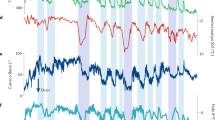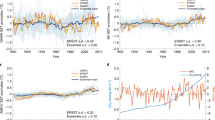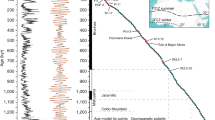Abstract
The oscillatory behaviour of the climate system on decadal timescales before the instrumental record is hard to quantify. However, knowledge of this variability is important for putting current changes in context and for supporting reliable future predictions. Here we investigate the recurrent component of Holocene climate variability in the North Atlantic sector from 10,500 to 2,000 years ago by conducting a frequency analysis of both an annually laminated climate record from a lake in England and outputs from a long transient simulation of the Atlantic meridional overturning circulation. We find consistent decadal variability over the past 6,700 years and before 8,500 years before present, probably reflecting predominance of solar and ocean forcings. Between these dates, climate variability was dampened on decadal timescales. Our results suggest that meltwater discharge into the North Atlantic and the subsequent hydrographic changes, from the opening of the Hudson Bay until the final collapse of the Laurentide Ice Sheet, disrupted the decadal cyclic signals for more than a millennium. Given the current acceleration of the Greenland Ice Sheet melting in response to global warming, this study provides long-term evidence of potential challenges predicting future patterns of the climate system.
This is a preview of subscription content, access via your institution
Access options
Access Nature and 54 other Nature Portfolio journals
Get Nature+, our best-value online-access subscription
$29.99 / 30 days
cancel any time
Subscribe to this journal
Receive 12 print issues and online access
$259.00 per year
only $21.58 per issue
Buy this article
- Purchase on Springer Link
- Instant access to full article PDF
Prices may be subject to local taxes which are calculated during checkout



Similar content being viewed by others
Data availability
The varve thickness data that support the findings of this study are available on PANGAEA (https://doi.pangaea.de/10.1594/PANGAEA.944411). Time-series data of the maximum AMOC at 52° N below 500 m (TraCE-21ka simulation) are available via https://www.earthsystemgrid.org/project/trace.html.
References
IPCC Special Report on the Ocean and Cryosphere in a Changing Climate (eds Pörtner, H.-O. et al.) (Cambridge Univ. Press, 2019); https://www.ipcc.ch/srocc/
Moffa-Sánchez, P. & Hall, I. R. North Atlantic variability and its links to European climate over the last 3000 years. Nat. Commun. 8, 1726 (2017).
Kushnir, Y. et al. Towards operational predictions of the near-term climate. Nat. Clim. Change 9, 94–101 (2019).
Meehl, G. A. et al. Decadal prediction: can it be skillful? Bull. Am. Meteorol. Soc. 90, 1467–1486 (2009).
Smith, D. M. et al. North Atlantic climate far more predictable than models imply. Nature 583, 796–800 (2020).
Boer, G. J. et al. The Decadal Climate Prediction Project (DCPP) contribution to CMIP6. Geosci. Model Dev. 9, 3751–3777 (2016).
Smith, D. M. et al. Robust skill of decadal climate predictions. NPJ Clim. Atmos. Sci. 2, 13 (2019).
Dunstone, N. et al. Skilful interannual climate prediction from two large initialised model ensembles. Environ. Res. Lett. 15, 094083 (2020).
Mann, M. E., Steinman, B. A. & Miller, S. K. Absence of internal multidecadal and interdecadal oscillations in climate model simulations. Nat. Commun. 11, 49 (2020).
O’Reilly, C. H., Woollings, T. & Zanna, L. The dynamical influence of the Atlantic multidecadal oscillation on continental climate. J. Clim. 30, 7213–7230 (2017).
Hernández, A. et al. Modes of climate variability: synthesis and review of proxy-based reconstructions through the Holocene. Earth Sci. Rev. 209, 103286 (2020).
Rehfeld, K., Hébert, R., Lora, J. M., Lofverstrom, M. & Brierley, C. M. Variability of surface climate in simulations of past and future. Earth Syst. Dyn. 11, 447–468 (2020).
Wanner, H. et al. Mid- to late Holocene climate change: an overview. Quat. Sci. Rev. 27, 1791–1828 (2008).
Lapointe, F. et al. Annually resolved Atlantic sea surface temperature variability over the past 2,900 y. Proc. Natl Acad. Sci. USA 117, 27171–27178 (2020).
Martin-Puertas, C. et al. The first Holocene varve chronology for the UK: based on the integration of varve counting, radiocarbon dating and tephrostratigraphy from Diss Mere (UK). Quat. Geochronol. 61, 101134 (2021).
Sutton, R., Suckling, E. & Hawkins, E. What does global mean temperature tell us about local climate? Phil. Trans. R. Soc. A 373, 20140426 (2015).
Hawkins, E. et al. Estimating changes in global temperature since the preindustrial period. Bull. Am. Meteorol. Soc. 98, 1841–1856 (2017).
Privalsky, V. E. Statistical predictability and spectra of air temperature over the Northern Hemisphere. Tellus A 35A, 51–59 (1983).
Peglar, S. M. The mid-Holocene Ulmus decline at Diss Mere, Norfolk, UK: a year-by-year pollen stratigraphy from annual laminations. Holocene https://doi.org/10.1177/095968369300300101 (1993).
Boyall, L., Valcarcel, J., Harding, P., Hernández, A. & Martin-Puertas, C. Disentangling the environmental signals recorded in Holocene calcite varves based on modern lake observations and annual sedimentary processes in Diss Mere, England. J. Paleolimnol. (in the press).
Rodwell, M. J., Rowell, D. P. & Folland, C. K. Oceanic forcing of the wintertime North Atlantic Oscillation and European climate. Nature 398, 320–323 (1999).
Sutton, R. T. & Hodson, D. L. R. Atlantic Ocean forcing of North American and European summer climate. Science 309, 115–118 (2005).
Comas-Bru, L. & Hernández, A. Reconciling North Atlantic climate modes: revised monthly indices for the East Atlantic and the Scandinavian patterns beyond the 20th century. Earth Syst. Sci. Data, 10, 2329–2344 (2018).
Liu, A. et al. Transient simulation of last deglaciation with a new mechanism for Bølling–Allerød warming. Science 325, 310–314 (2009).
He, F. Simulating Transient Climate Evolution of the Last Deglaciation with CCSM3. PhD thesis, University of Wisconsin-Madison (2011).
Osman, M. B. et al. Globally resolved surface temperatures since the Last Glacial Maximum. Nature 599, 239–244 (2021).
Davis, B. A. S., Brewer, S., Stevenson, A. C. & Guiot, J. The temperature of Europe during the Holocene reconstructed from pollen data. Quat. Sci. Rev. 22, 1701–1716 (2003).
Hale, G. E., Ellerman, F., Nicholson, S. B. & Joy, A. H. The magnetic polarity of sun-spots. Astrophys. J. 49, 153 (1919).
Schlesinger, M. E. & Ramankutty, N. An oscillation in the global climate system of period 65–70 years. Nature 367, 723–726 (1994).
Kerr, R. A. A North Atlantic climate pacemaker for the centuries. Science 288, 1984–1985 (2000).
Yu, G. & Harrison, S. P. Holocene changes in atmospheric circulation patterns as shown by lake status changes in northern Europe. Boreas 24, 260–268 (1995).
Barber, D. C. et al. Forcing of the cold event of 8,200 years ago by catastrophic drainage of Laurentide lakes. Nature 400, 344–348 (1999).
Gregoire, L. J., Ivanovic, R. F., Maycock, A. C., Valdes, P. J. & Stevenson, S. Holocene lowering of the Laurentide Ice Sheet affects North Atlantic gyre circulation and climate. Clim. Dyn. 51, 3797–3813 (2018).
Matero, I. S. O., Gregoire, L. J., Ivanovic, R. F., Tindall, J. C. & Haywood, A. M. The 8.2 ka cooling event caused by Laurentide ice saddle collapse. Earth Planet. Sci. Lett. 473, 205–214 (2017).
Carlson, A. E. et al. Rapid early Holocene deglaciation of the Laurentide Ice Sheet. Nat. Geosci. 1, 620–624 (2008).
Hillaire-Marcel, C., de Vernal, A. & Piper, D. J. W. Lake Agassiz final drainage event in the northwest North Atlantic. Geophys. Res. Lett. 34, L15601 (2007).
Gregoire, L. J., Payne, A. J. & Valdes, P. J. Deglacial rapid sea level rises caused by ice-sheet saddle collapses. Nature 487, 219–222 (2012).
Clark, P. U. et al. Freshwater forcing of abrupt climate change during the last glaciation. Science 293, 283–287 (2001).
Thornalley, D. J. R. et al. Long-term variations in Iceland–Scotland overflow strength during the Holocene. Clim. Past 9, 2073–2084 (2013).
Ayache, M., Swingedouw, D., Mary, Y., Eynaud, F. & Colin, C. Multi-centennial variability of the AMOC over the Holocene: a new reconstruction based on multiple proxy-derived SST records. Glob. Planet. Change 170, 172–189 (2018).
Wassenburg, J. A. et al. Reorganization of the North Atlantic oscillation during early Holocene deglaciation. Nat. Geosci. 9, 602–605 (2016).
Ullman, D. J. et al. Final Laurentide Ice-Sheet deglaciation and Holocene climate–sea level change. Quat. Sci. Rev. 152, 49–59 (2016).
Hillaire-Marcel, C., de Vernal, A., Bilodeau, G. & Weaver, A. J. Absence of deep-water formation in the Labrador Sea during the last interglacial period. Nature 410, 1073–1077 (2001).
Yan, X., Zhang, R. & Knutson, T. R. Underestimated AMOC variability and implications for AMV and predictability in CMIP models. Geophys. Res. Lett. 45, 4319–4328 (2018).
Lapointe, F. & Bradley, R. S. Little Ice Age abruptly triggered by intrusion of Atlantic waters into the Nordic Seas. Sci. Adv. https://doi.org/10.1126/sciadv.abi8230 (2021).
Sirocko, F. et al. Muted multidecadal climate variability in central Europe during cold stadial periods. Nat. Geosci. 14, 651–658 (2021).
Swingedouw, D. et al. AMOC recent and future trends: a crucial role for oceanic resolution and Greenland melting? Front. Clim. 4, 838310 (2022).
Moffa-Sánchez, P. et al. Variability in the northern North Atlantic and Arctic oceans across the last two millennia: a review. Paleoceanogr. Paleoclimatol. 34, 1399–1436 (2019).
Aguiar, W. et al. Magnitude of the 8.2 ka event freshwater forcing based on stable isotope modelling and comparison to future Greenland melting. Sci. Rep. 11, 5473 (2021).
Aschwanden, A. et al. Contribution of the Greenland Ice Sheet to sea level over the next millennium. Sci. Adv. 5, eaav9396 (2019).
Martin-Puertas, C. Varve thickness record of Diss Mere (UK). Pangaea https://doi.pangaea.de/10.1594/PANGAEA.944411 (2022).
Yeager, S. G., Shields, C. A., Large, W. G. & Hack, J. J. The low-resolution CCSM3. J. Clim. 19, 2545–2566 (2006).
Peltier, W. R. Global glacial isostasy and the surface of the Ice-Age Earth: the ICE-5G (VM2) model and GRACE. Annu. Rev. Earth Planet. Sci. 32, 111–149 (2004).
Khider, D. et al. Pyleoclim: Paleoclimate timeseries analysis and visualization with Python. Paleoceanogr. Paleoclimatol. 37, e2022PA004509 (2022).
Pardo-Igúzquiza, E. & Rodríguez-Tovar, F. J. MAXENPER: a program for maximum entropy spectral estimation with assessment of statistical significance by the permutation test. Comput. Geosci. 31, 555–567 (2005).
Ulrych, T. J. & Bishop, T. N. Maximum entropy spectral analysis and autoregressive decomposition. Rev. Geophys. 13, 183–200 (1975).
Pardo-Igúzquiza, E. & Rodríguez-Tovar, F. J. Maximum entropy spectral analysis of climatic time series revisited: assessing the statistical significance of estimated spectral peaks. J. Geophys. Res. Atmos. 111, D10102 (2006).
Liu, Y., Liang, X. S. & Weisberg, R. H. Rectification of the bias in the wavelet power spectrum. J. Atmos. Ocean. Technol. 24, 2093–2102 (2007).
Acknowledgements
This study was funded by the Royal Society. C.M.-P. is supported by a Royal Society Dorothy Hodgkin Fellowship (ref: DH150185) and a UKRI Future Leaders Fellowship (MR/W009641/1). A.H. is supported by the Spanish Ministry of Science and Innovation through the Ramón y Cajal Scheme (RYC2020-029253-I). We thank P. Ortega and E. Moreno-Chamarro for valuable discussions. We also thank A. Walsh and G. Biddulph for varve counting in some sections of the record, A. Zhao for plotting complementary climate datasets that helped with the interpretation of the proxy record, A. Brauer and his team for lake coring, and the Diss Council for support during fieldwork.
Author information
Authors and Affiliations
Contributions
C.M-P. led the research, performed the palaeolimnological study and wrote the paper. A.H. contributed to the discussion and interpretation of the results and the writing of the manuscript. E.P.-I. performed the statistical analysis of the proxy data and AMOC simulation and contributed to the writing of the manuscript. L.B. contributed to the palaeoclimate interpretation of the proxy record, data analysis and the writing of the manuscript. C.B. and Z.J. analysed the AMOC in TraCE-21ka simulation, interpreted the results related to the AMOC simulation and contributed to the writing of the manuscript. R.T. measured the XRF data. S.P.E.B. contributed to the chronology of the proxy record. F.J.R.-T. visualized the potential of the proxy record for cyclostratigraphy. All co-authors contributed to the discussion of the results and provided feedback on the manuscript.
Corresponding author
Ethics declarations
Competing interests
The authors declare no competing interests.
Peer review
Peer review information
Nature Geoscience thanks Paul Zander and the other, anonymous, reviewer(s) for their contribution to the peer review of this work. Primary Handling Editor: James Super, in collaboration with the Nature Geoscience team.
Additional information
Publisher’s note Springer Nature remains neutral with regard to jurisdictional claims in published maps and institutional affiliations.
Extended data
Extended Data Fig. 1 Correlation of TraCE-21ka simulations and the Diss Mere varve thickness records.
a) Pearson correlation of TraCE-21ka AMOC simulation (t + lag) and the Diss Mere varve thickness (t) with 95% bootstrapped confidence region; b) Pearson correlation of TraCE-21ka Temperature simulation (t + lag) and thickness of the calcite layer in Diss Mere (t) with 95% bootstrapped confidence region; c) Correlation matrix between the Diss Mere varve thickness records and TraCE-21ka simulations. Correlations coefficients discussed in the article are shown in bold.
Extended Data Fig. 2 Time-frequency analysis of the Diss Mere varve and seasonal layers thickness records.
Maximum entropy power spectrograms of total varve thickness / annual signal (top), organic layer thickness / winter signal (middle) and calcite layer thickness / summer signal (bottom). Frequency is given in cycles per year and the colour bar (power) has been represented with a logarithmic scale.
Supplementary information
Supplementary Information
Supplementary Figs. 1–6, Results and Discussion.
Rights and permissions
Springer Nature or its licensor (e.g. a society or other partner) holds exclusive rights to this article under a publishing agreement with the author(s) or other rightsholder(s); author self-archiving of the accepted manuscript version of this article is solely governed by the terms of such publishing agreement and applicable law.
About this article
Cite this article
Martin-Puertas, C., Hernandez, A., Pardo-Igúzquiza, E. et al. Dampened predictable decadal North Atlantic climate fluctuations due to ice melting. Nat. Geosci. 16, 357–362 (2023). https://doi.org/10.1038/s41561-023-01145-y
Received:
Accepted:
Published:
Issue Date:
DOI: https://doi.org/10.1038/s41561-023-01145-y



